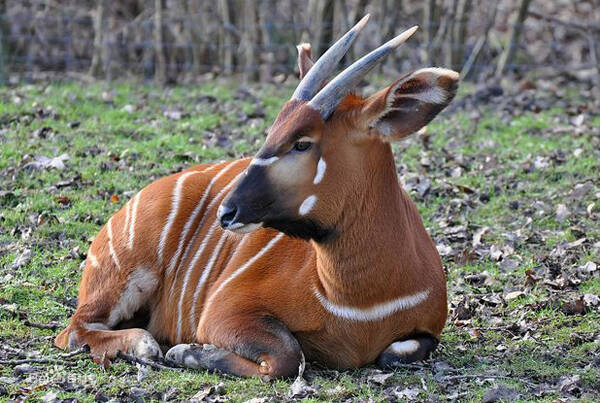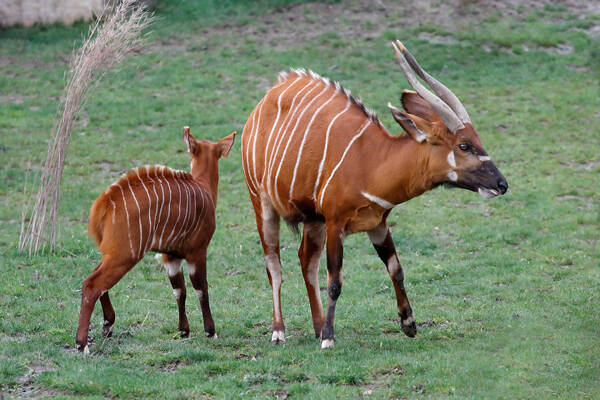Tragelaphus eurycerus
IUCN
LCBasic Information
Scientific classification
- name:Tragelaphus eurycerus
- Scientific Name:Tragelaphus eurycerus
- Outline:Ungulata
- Family:Artiodactyla Bovidae Sapir
Vital signs
- length:170-250cm
- Weight:210-405kg
- lifetime:About 20 years
Feature
The fur is reddish brown with fine white stripes
Distribution and Habitat
Mainly distributed in isolated areas of Kenya (eastern subspecies) and most countries in West Africa (western subspecies).
Origin: Benin, Cameroon, Central African Republic, Congo, Democratic Republic of Congo, Côte d'Ivoire, Gabon, Ghana, Guinea, Kenya, Liberia, Niger, Sierra Leone, South Sudan, Togo.
Regional extinction: Uganda.
Inhabits moist, dense and near-water forests at the foot of mountains at an altitude of 2000-3000 meters.
Appearance
There are two subspecies of the antelope. They are large, with a body length of 170-250 cm, a shoulder height of 110-130 cm, and a tail length of 45-60 cm. Female sheep weigh 210-235 kg; male sheep weigh 240-405 kg. The ears are particularly wide; the back and sides of the body are bright brown-red, and the abdomen is black. The hair is short and smooth, with white spots on the forehead and sides of the head, a white crescent-shaped horizontal spot on the chest, and 11-12 vertical white stripes on the sides of the body; the back has dark short mane from the head to the buttocks, and the tail end has dark chestnut to black long hair; the limbs are slender, dark on the outside, white on the inside, and white on the knees and the upper front of the hoof. Both males and females have horns, with an average length of 83.5 cm and a maximum of 1 meter. The horns are sandy yellow and twisted in a spiral shape.
Details
There are two subspecies of the eurycerus (scientific name: Tragelaphus eurycerus), and the names come from Greek. "Tragelaphus" is a combination of "goat" (trag) and "deer" (elaphos), and "eurycerus" is composed of "universal" (eurus) and "horn" (keras). These two words vividly illustrate the physiological characteristics of the eurycerus, which looks like both deer and sheep, and the male and female forms are basically the same. The English name "bongo" comes from the local dialect in West Africa, which means "small drum". The reason for the name may be that this animal is alert by nature, and even the slightest noise will stimulate it to run away.

The most active time for the purple antelope is at dawn and dusk. They live in small family groups, consisting of one male and eight females. They have keen hearing and are agile. When startled, they can escape at great speed through the dense forest covered with vines. It mainly feeds on grass, but also eats tender branches, young shoots, vines, and leaves of various plants. It can use its horns to dig for roots and rhizomes, and especially likes to eat tender branches growing at the base of tree trunks. It can put its forelimbs on the tree trunk to make its body upright to feed branches and leaves up to 2.5 meters high. It likes to eat wood ash and obtain salt from it.
The breeding season of the purple antelope can form a large group of more than 50. Females have a gestation period of 9 months and give birth from December to January of the following year, with one baby per litter. After birth, the lambs are left alone in the birthing area for a short period of time, still lying in a sheltered place to avoid being chased by predators. The ewes return regularly to feed the lambs. The lambs are weaned after six months and reach sexual maturity at about 20 months.

The antelope is facing a continuous decline in numbers, mainly due to habitat destruction, hunting, human settlement expansion and commercial forest development. The spread of diseases brought by human grazing cattle also puts great pressure and impact on the antelope. It is reported that the antelope has declined significantly in the 1890s. Entering the 20th century, due to the attention of animal protection organizations, the population has increased. However, the World Conservation Union assesses that it is still in a near-threatened state.
Listed in the 2016 IUCN Red List of Threatened Species ver3.1 - Near Threatened (NT).
Protect wild animals and eliminate game.
Maintaining ecological balance is everyone's responsibility!








